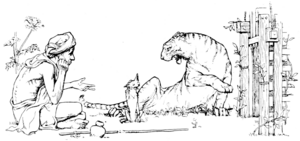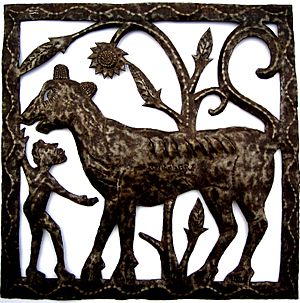The Tiger, the Brahmin and the Jackal facts for kids
The Tiger, the Brahmin and the Jackal is a very old and popular fairy tale from India. It has many different versions. A woman named Mary Frere put a version of this story in her book, Old Deccan Days, in 1868. This was the first time Indian folktales were collected in English. Another version was in Joseph Jacobs' book, Indian Fairy Tales. However, the story is much older, appearing in the ancient Indian collection called the Panchatantra between 200 BCE and 300 CE.
What Happens in the Story?
The story begins with a kind brahmin (a wise person in Indian society) walking past a tiger caught in a trap. The tiger begs the brahmin to let him go, promising he will not eat him. The brahmin feels sorry for the tiger and sets him free.
But as soon as the tiger is out, he forgets his promise! He tells the brahmin he is going to eat him. The brahmin is shocked and tells the tiger how unfair this is. They agree to ask the first three things they meet to decide who is right.
First, they meet a tree. The tree says that humans often cut its branches and don't treat it well. So, the tree thinks it's fair for the tiger to eat the brahmin.
Next, they meet a buffalo. The buffalo explains that humans use it for milk and work, then abandon it when it gets old. The buffalo also agrees that the brahmin should be eaten.
Finally, they meet a clever jackal. The jackal feels bad for the brahmin. He pretends not to understand what happened and asks to see the trap. Once they are back at the trap, the jackal says he still doesn't get it. The tiger, wanting to show clearly, gets back into the trap. Quick as a flash, the jackal shuts the trap door! He then tells the brahmin that they should leave the tiger right where he is.
Different Versions of the Tale

There are more than one hundred versions of this story found all over the world! In some versions, the animal that gets released from the trap is a crocodile, a snake, or even a wolf instead of a tiger.
The famous story expert Joseph Jacobs said that this tale comes from very old Indian writings. Some versions are truly ancient, dating back to the Panchatantra (also known as Fables of Bidpai) and the Jataka tales.
This story also traveled to Europe. It appeared about 900 years ago in a book called Disciplina Clericalis by Petrus Alphonsi. Later, it showed up in other European collections like the Gesta Romanorum.
Today, you can find modern illustrated books of this tale, such as The Tiger, the Brahmin & the Jackal with pictures by David Kennett. There's also The Tiger and the Brahmin illustrated by Kurt Vargo. Rabbit Ears Productions even made a video version of the last book, narrated by the famous actor Ben Kingsley, with music by Ravi Shankar. This video version changes some parts of the story. For example, an elephant is included as one of the animals the brahmin asks for an opinion.


